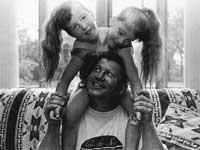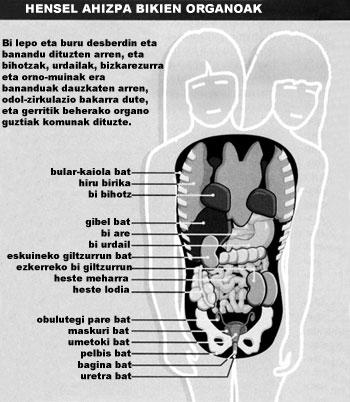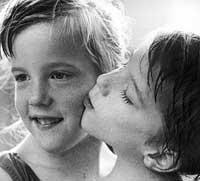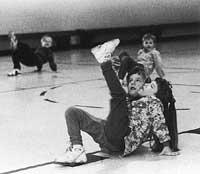The most intimate bond
They are sitting in front of a table, playing, in a nursery room. And when a visitor asks curiously (how many are 10 plus 10? ), Brittany, one of her sisters, starts counting on her fingers. Immediately, her twin sister, Abigail, offers her help by placing her hand on the table. Children count their fingers and toes with the accuracy of their six years. Nineteen” answer the visitor and when he asks them the following question (how many years do you think I have? ), Brittany cannot stand and responds “900,000”. They begin with irritation and applaud, raising their hand in greeting.

They love jokes and naturally perform a series of actions that, thanks to their humor, would be incomprehensible to any of us: two arms, counting the fingers to make calculations, and to caress and embrace their parents, who correspond with one body.
Abigail controls the right limbs (arm and leg) and Brittany the left. Although two necks and heads are different and separate, and they also have separate hearts, stomach, spine and spinal cord, they have a unique blood circulation and all lower organs at the waist are common. In medical language they are known as united twins, but two people are very different, they have different opinions, tastes and dreams.
For six years, the Hensel family has developed a quiet life in a small village in the Midwest of the United States (which they do not want to make known the country of residence). They go shopping with their parents and their sister and their younger sister. They attend school and participate in sports competitions.
And until recently their parents opened their doors and their hearts to LIFE magazine, their journalists and photographers, the life of the twins was unknown, but since they appeared on the cover of the magazine last April their story, as exciting as delicate, has passed to the voice of the people.
However, the two girls are more than just a rarity: their ridiculous faces and their apparent health make anyone feel unable to make a surgical attempt to separate twins, especially considering that these types of operations usually require sacrificing one of the twins so that the other lives “normal”. Without forgetting what it can mean to force only those who survive to live.
The associated twins are a curious fact in the world of a birthing room. Only one in every 50,000 births are born, of which 40% are born dead and, interestingly, 70% are girls. The associated twins are always identical: the fruits of a single egg are, for unknown reasons, the fruits of an egg that cannot be completely divided in the first three weeks of pregnancy. In the United States about 40 cases can be born annually. Simple identical twins (unicycle) are 400 times more.
The associated twins are known as Siamese, in memory of two brothers called Eng and Chang. These two brothers, born in Siam (in present-day Thailand), were united from the chest by a flexible band of cartilage (which would be easily released by current surgery), and after passing through a rarity exposed in circuses, they lived 63 years (brand that remains record today). The most common cases in the medical literature are those related to the chest or abdomen, although the possible forms of union are more than twelve. Diencephalic twins, i.e. twins with two heads but one body and two upper and two lower limbs, are extremely rare and only 3-4 cases are known throughout history.

The parents of the twins had no idea what was going to happen; Patty, the emergency nurse of a 36-year-old hospital, arrived normally in the last days of her pregnancy. During pregnancy there was no unexpected or error, all studies and tests, including those performed with ultrasound, indicated the single, normal fetus. Later, the doctors thought that the heads of the two girls were aligned while the sonogram was being done. His father, Mike, worked in the construction industry and, once he heard or thought he had heard the heartbeats of two hearts, immediately forgot this “impression”.
As the fetus was in a gluteal position, doctors thought of the cesarean section. While her husband was out, Patty was anesthetized and the doctor pulled out the fetus: first the gluteas, then the legs and finally to everyone's surprise, they pulled out two heads. All of them remained silent for about 30 seconds and the family doctor who was there.
My father remembers very well how they gave him the news: "They told me, they have one body and two heads." His mother, even under the influence of anesthesia, heard the word and understood nothing. Have I had cats?
The children were transferred to a children's hospital in a nearby town. “We thought they were going to die,” recalls Patty, who was normally in bed in the hospital where he worked, when tension soared. But after seeing that the health of the children was good, and after getting into a routine like “bathing/eating/caressing” every day, they began to clear all their fears, embarrassment or doubts and to think that everything could go well. And so it has been.
At 4 months, a surgical operation was carried out to remove the third elbow between the two heads, which was useless and also caused discomfort. Since then they have not needed any surgery. They have been hospitalized three times and in all cases for a short time: two for a Brittany pneumonia and one for a renal infection.

What about the future?
Joy Westerdahl, a family doctor, says it is very difficult to predict in the long term, but at the moment the health of both girls is good. Brittany says catarros and the like are easier to catch than their sisters. Since her blood circulation is unique, the mother says that when Abigail takes the medication she has realized that Brittany's ear infection improves. And the family medit says: “Twins need a single dose of vaccination, apparently they don’t feel like getting two punctures.”
Although they have several common organs (a single, large liver, and the bladder, intestines, and the only reproductive organs for both), their nervous systems are different. If you tickle Abigail at her side, anywhere from her head to her toes, Brittany feels nothing, except in a small, narrow area of her back, where they apparently share feelings. Two sisters experience different feelings of hunger and sleep, as well as feelings of urination or sleep.
Learning to walk around fifteen months shows us well the enthusiasm, decision and miracle of teamwork. Mrs. Nancy Oltrogge, who cared for the children during the day and oversaw the rise of two, says that “we extolled and greatly praised the children,” but had never been taught how, when or what foot they had to move. “They knew what they were going to do.” On one occasion they did not agree when choosing the path to follow, and suddenly they began to turn around. But gradually they have learned to walk, swim and even bike, and little by little.

Nobody knows yet how it is possible for these two brains to synchronize all those complex movements in the right way. The girl may unwittingly become aware of the displacement of her member. But how to understand the coordination that requires a movement to applaud with both hands? “I don’t think we are ever able to respond,” says Westerdahl.
The idea of separating the twins was discarded from the beginning, as soon as the doctors informed them that there was very little chance that both would come alive. How could we choose between the two? asks his father. The mother, as a nurse, represents a hard life after the operation (if surgery were possible): after several operations, the two children are condemned to live on a wheel. “If we had to operate, it would be better to divide it from top to bottom in half,” says the mother.
Benjamin Carson, head of the neurosurgery department at Johns Hopkins Children's Hospital in Baltimore, an expert in surgical operations for the separation of associated twins, is of the same opinion. “If the two sisters were in banparia, a couple with movement capacity would basically get two totally invalid and invalid.” He even questions if both of them had left alive.
The closest case in which such a separation occurred may be that of the Eilish and Katie Holton twins of Ireland. They were born similarly, but with four arms instead of three. In 1992 and at the age of three, the girls separated into a long 15-hour surgical program at the Great Ornond Street Children's Hospital in London, where 25 doctors participated. Katie died four days later from heart problems. Eilish continues to live and has a small lame for his artificial leg. The Holton visited with their daughter the Hensel in 1994.
Patty and Mike, their parents, are worried that they don't know what will happen when children reach adolescence. The time will come when children will feel like separating, says surgeon Carson, but such operations have never been successful after their childhood. They will have to decide. In addition to the physical or surgical difficulties, a distribution of these characteristics would mean an enormous emotional trauma for both sisters.

At the moment, the children seem happy with their situation. “I don’t want to separate myself,” says Brittany. And after meeting Holton, the only twin, he somehow knows the dangers of the operation. Each of the two sisters has a strong and outstanding sense of identity. “Everyone does their own work,” says Stahlke, a children’s teacher. “When we do tests or tests, it would be easy for them to copy, but they never do. When one makes a mistake in some school exercise, the other always does it correctly. And that surprises me.”
Abigail wants to be a dentist while Brittany wants to drive planes for the moment. “It has to be hard, that’s why piloting an airplane while one drives, the other works like in the marble next to you, working with your teeth,” says the father in the form of a joke. Are you going to find a good husband? “And why not?” says Mike. Other associated twins are married (so did the original Siamese). “They look pretty. They are fast. For this they have everything in favor,...” he says and after a pause ends like this: “except linking”.





